In the field of Machine Learning, choosing the right programming language makes a significant difference in productivity, performance and ease of learning. Although, many languages are available, a few stand out for their extensive libraries, strong communities and versatility. If you want to build an artificial neural network, analyze large datasets, or implement deep learning algorithms, the right and best programming language will simplify the process.
In this post, we shall explore the top 5 programming languages for machine learning in 2025. We shall understand each language’s strengths and weaknesses, their suitability for different Machine Learning tasks and popular libraries that enhance their capabilities.
Best Programming Languages for Machine Learning
We discuss about most popular languages for Machine Learning and AI task; along with their pros and cons and suitability for particular tasks.
1. Python
Overview
Python remains the most popular programming language for machine learning, known for its simplicity, readability and large ecosystem of libraries. It is often the first choice for both beginners and experienced Machine Learning engineers.
Pros
– Ease of Use: Python’s syntax is simple and close to natural language, which makes it easy to learn and understand.
– Extensive Libraries: Libraries like TensorFlow, PyTorch, Scikit-Learn and Keras provide everything from data pre-processing to complex deep learning architectures.
– Strong Community Support: Python has a large, active community, which means plenty of tutorials, forums and resources.
Cons
– Performance: Python is slower than compiled languages like C++ or Java, although libraries often use optimized, low level code.
– Mobile and Web Deployment: Python can be less efficient for mobile and web deployment, though tools like TensorFlow Lite are helping to bridge the gap.
Suitability for ML Tasks
– Deep Learning: Thanks to TensorFlow and PyTorch.
– Data Analysis: With libraries like Pandas and NumPy.
– Natural Language Processing (NLP): With libraries like NLTK and SpaCy.
Popular ML Libraries in Python
– TensorFlow: An open source library by Google, popular for deep learning applications.
– Scikit-Learn: Excellent for data mining and data analysis tasks, especially for beginners.
– Keras: A high level neural networks API, written in Python and capable of running on top of TensorFlow.
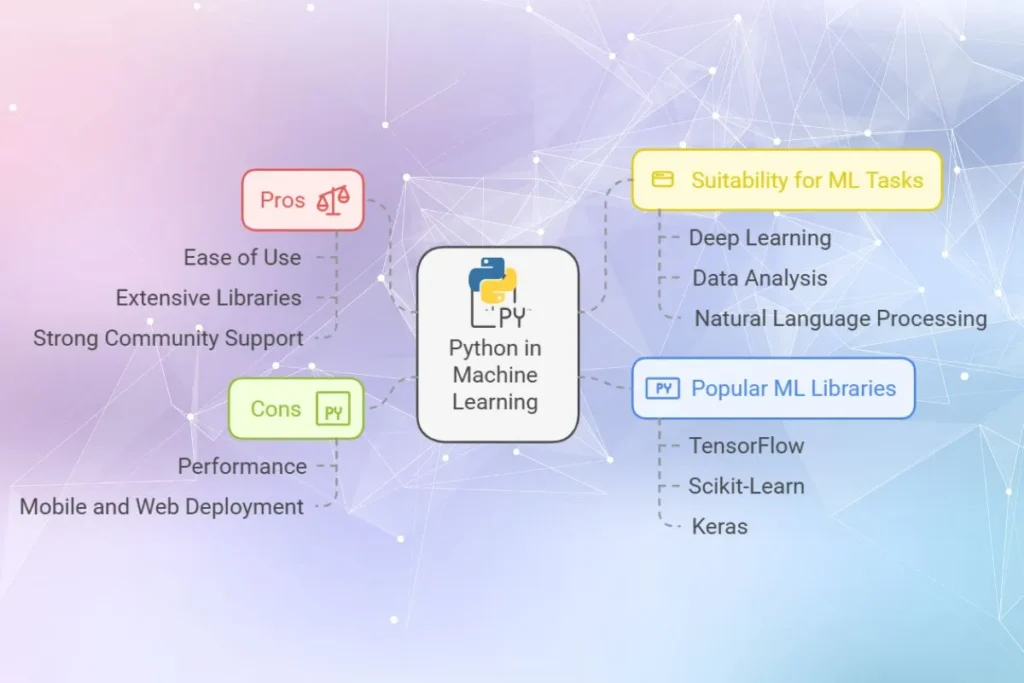
2. R
Overview
R is a programming language specifically designed for data analysis and statistical computing. It is particularly popular in academia and among data scientists who need powerful tools for statistical analysis and visualization.
Pros
– Strong in Statistical Analysis: R was built for statistics, which makes it excellent for exploratory data analysis (EDA) and data visualization.
– Robust Packages: Packages like `caret` and `randomForest` offer extensive tools for machine learning.
– Data Visualization: Libraries like `ggplot2` and `plotly` make it easy to create complex data visualizations.
Cons
– Slower for Larger Datasets: R can struggle with performance on very large datasets, particularly compared to Python and C++.
– Steep Learning Curve: The syntax and structure of R can be challenging for beginners, especially those unfamiliar with statistical programming.
Suitability for ML Tasks
– Data Analysis and Visualization: Ideal for exploratory data analysis and model interpretability.
– Statistical Modeling: Great for projects that require in depth statistical information, such as in research or academic work.
– Healthcare and Bioinformatics: R is commonly used in scientific research, especially in genomics and clinical data analysis.
Popular ML Libraries in R
– caret: A package that unifies the training and tuning of various machine learning algorithms.
– randomForest: A robust library for building decision tree based models.
– nnet: Useful for neural networks and other simple machine learning models.
– e1071: Offers support for basic machine learning algorithms like SVM and Naive Bayes.
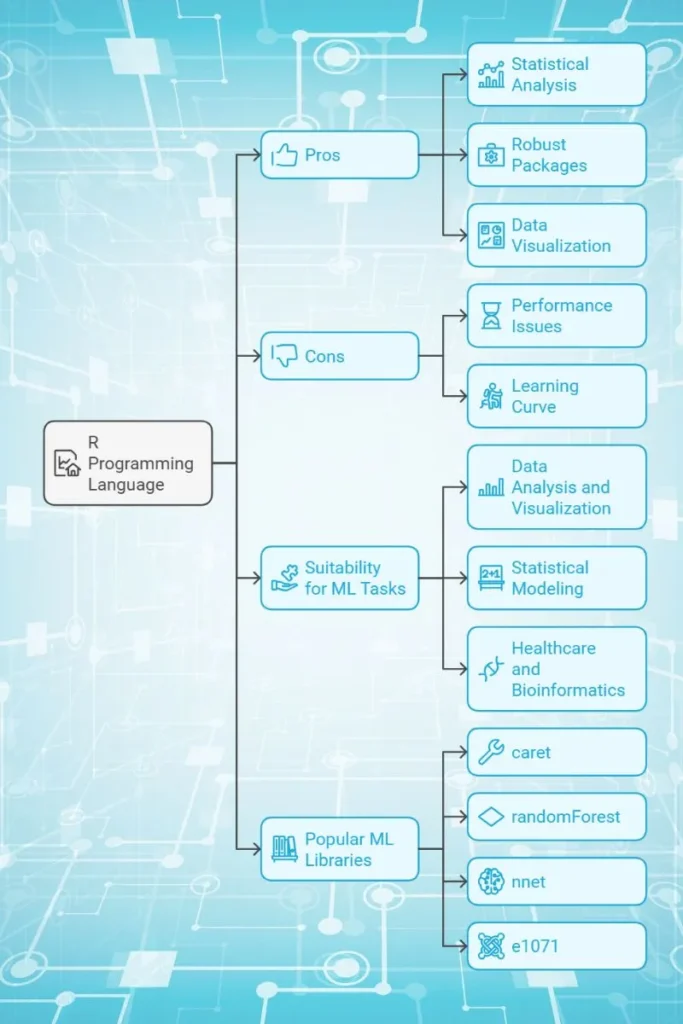
3. Julia
Overview
Julia is a high performance language that has gained popularity for machine learning and data science. It was designed to handle numerical and scientific computing and it combines the speed of C++ with the ease of Python.
Pros
– High Performance: Julia is fast, which makes it ideal for handling large datasets and complex computations.
– Easy Syntax: Julia’s syntax is straightforward, similar to Python, which makes it easy for new users to learn.
– Scalable: Julia scales well from small applications to large, suitable for distributed computing environments.
Cons
– Smaller Ecosystem: Julia’s library ecosystem is not as mature as Python’s, although it is growing.
– Less Community Support: Julia has a smaller community, which means fewer resources and support forums than Python or R.
Suitability for ML Tasks
– High-Performance ML Models: Where speed is critical, such as in real time systems.
– Scientific Computing: Ideal for fields like physics, engineering and bioinformatics.
– Research and Prototyping: Julia allows for quick prototyping with minimal performance trade offs.
Popular ML Libraries in Julia
– Flux.jl: A flexible and easy to use machine learning library.
– MLJ.jl: Julia’s ecosystem for machine learning, similar to Python’s Scikit-Learn.
– Turing.jl: A probabilistic programming library for Bayesian inference.
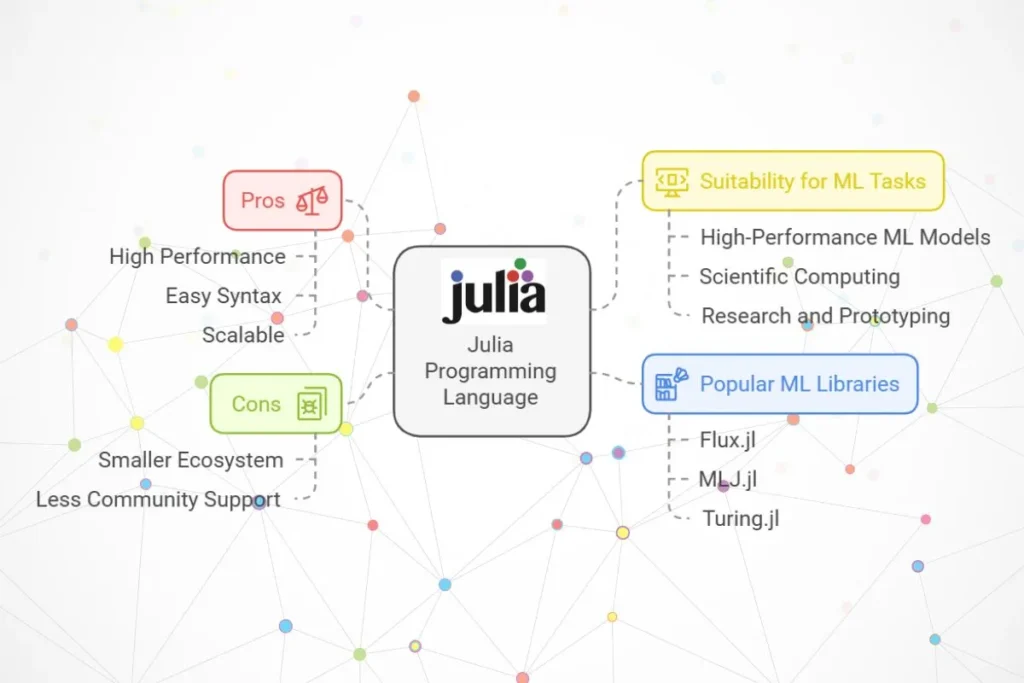
4. JavaScript (Node.js)
Overview
JavaScript, particularly when used with Node.js, is emerging as a useful language for machine learning on the web. It is particularly relevant for applications that need to run directly in the browser or integrate with web applications.
Pros
– Browser Compatibility: JavaScript allows Machine Learning models to run directly in the browser, which makes it ideal for web based applications.
– Node.js Support: With Node.js, JavaScript can handle backend ML tasks, which enables end to end development.
– Growing ML Libraries: Libraries like TensorFlow.js bring Machine Learning capabilities directly to the browser.
Cons
– Limited by Browser Performance: JavaScript’s performance is restricted by browser capabilities, which can be limiting for complex models.
– Less Specialized: JavaScript lacks the specialized Machine Learning features of Python or R, which makes it less versatile for certain types of Machine Learning tasks.
Suitability for ML Tasks
JavaScript is suitable for lightweight machine learning applications that run in the browser or need to integrate seamlessly with web apps. Examples include interactive visualizations, real time data analysis and simple NLP tasks.
Popular ML Libraries in JavaScript
– TensorFlow.js: A JavaScript library for building and running Machine Learning models in the browser.
– Brain.js: A library for neural networks in JavaScript, designed for simplicity.
– Synaptic: An architecture free neural network library for JavaScript.
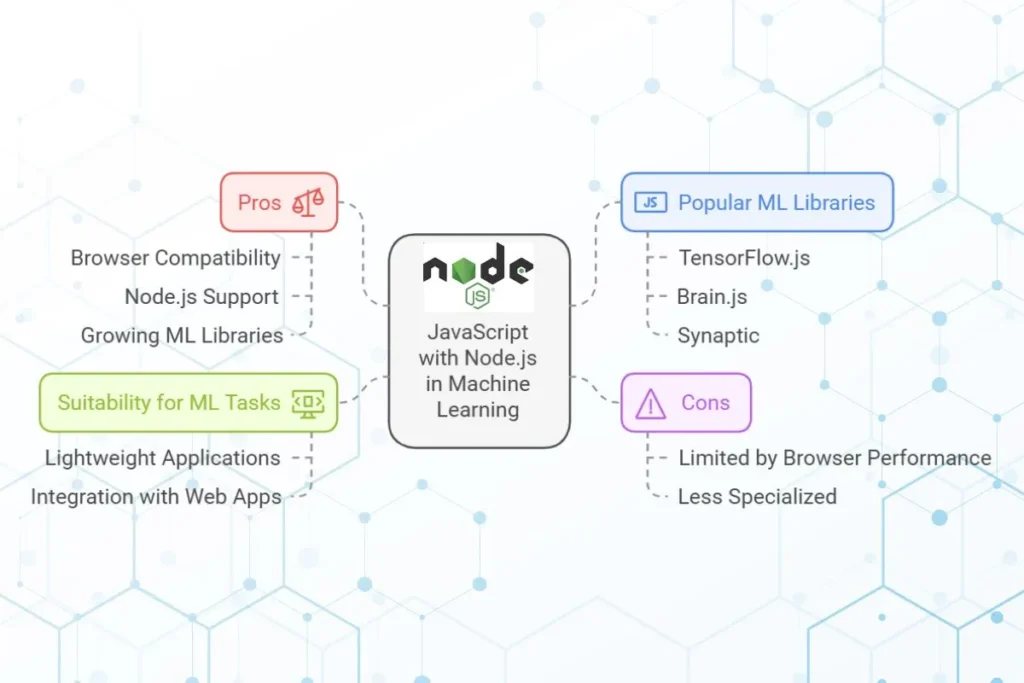
5. Java
Overview
Java is a popular general purpose language, especially in enterprise environments. Its strength and scalability make it ideal for large scale machine learning applications and it is widely used in production environments.
Pros
– Performance and Scalability: Java is highly performant and suitable for building large scale, enterprise level Machine Learning applications.
– Strong Ecosystem: Libraries like Weka and Deeplearning4j provide strong support for machine learning.
– Compatibility with Big Data Tools: Java is compatible with Hadoop and Spark, which makes it ideal for big data applications.
Cons
– Steeper Learning Curve: Java has a more complex syntax compared to Python.
– Less Flexible for Rapid Prototyping: Java is less suited for quick experiments and data exploration due to its verbose syntax.
Suitability for ML Tasks
Java is well suited for production grade Machine Learning applications that require scalability and reliability. It is commonly used in finance, e-commerce and large enterprise environments.
Popular ML Libraries in Java
– Weka: A collection of machine learning algorithms for data mining tasks.
– Deeplearning4j: A deep learning library that supports Java and can run on distributed systems.
– MOA: A stream mining library for real time analytics.
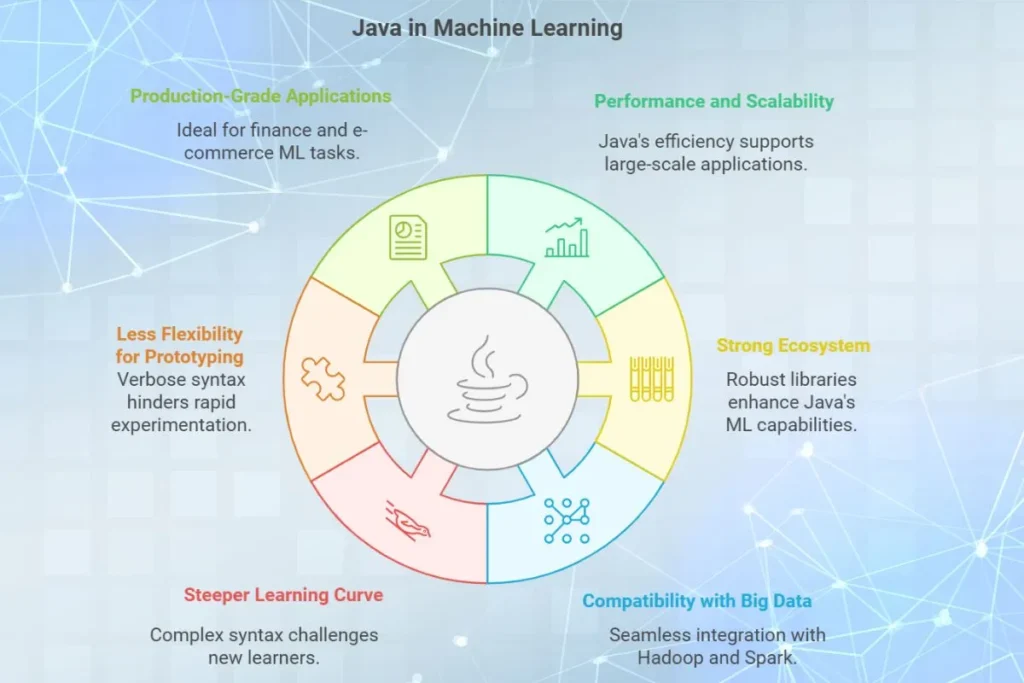
Comparison Table
| Language | Strengths | Weaknesses | Popular Libraries |
| Python | Ease of use, extensive libraries | Slower performance, limited web/mobile deployment | TensorFlow, Scikit-Learn, Keras |
| R | Statistical analysis, data visualization | Slower for large datasets | caret, randomForest, ggplot2 |
| Julia | High performance, easy syntax | Smaller ecosystem, less support | Flux.jl, MLJ.jl, Turing.jl |
| JavaScript | Browser compatibility, Node.js support | Limited by browser performance | TensorFlow.js, Brain.js, Synaptic |
| Java | Performance, scalability | Complex syntax, less rapid prototyping | Weka, Deeplearning4j, MOA |
Conclusion
The best programming language for machine learning depends on your specific project requirements, your background and the type of application you are developing. Python is an excellent all around choice, particularly for beginners and those focused on deep learning. R is ideal for statistical analysis, Julia shines in high performance computing, JavaScript is perfect for web based Machine Learning applications and Java is well suited for enterprise solutions.
Choose the right language which provides you the best tools and flexibility you need to build powerful machine learning models.
Disclaimer: The websites mentioned above might evolve over time. Always refer to the website and their official documentation for the most accurate and updated information as well as latest offerings, plans and prices etc.

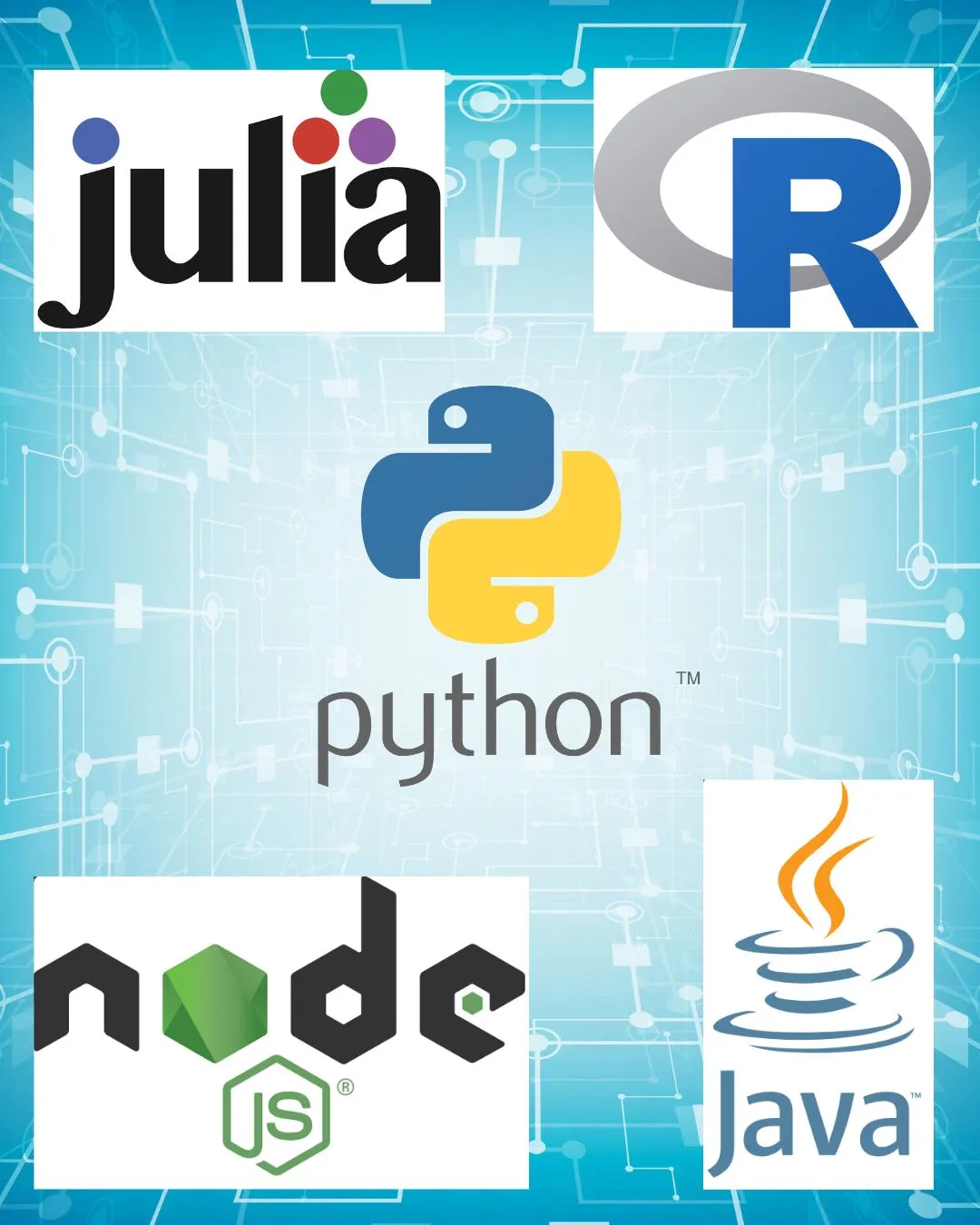
Reading your article helped me a lot and I agree with you. But I still have some doubts, can you clarify for me? I’ll keep an eye out for your answers.